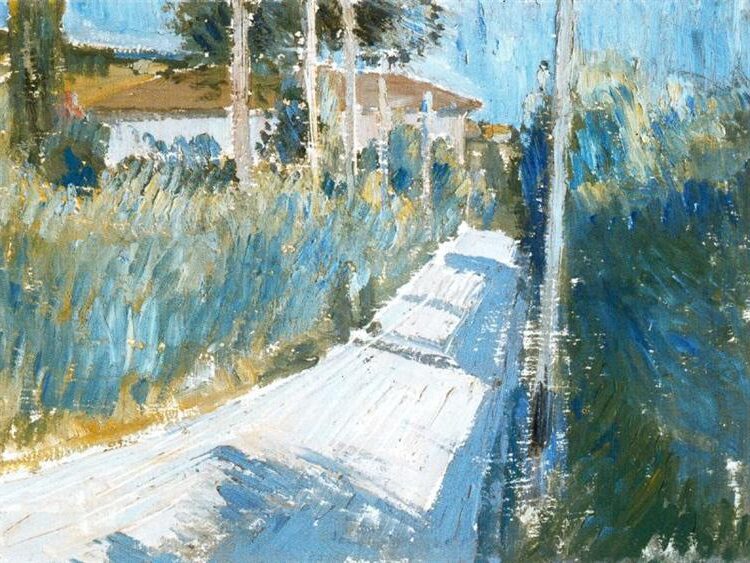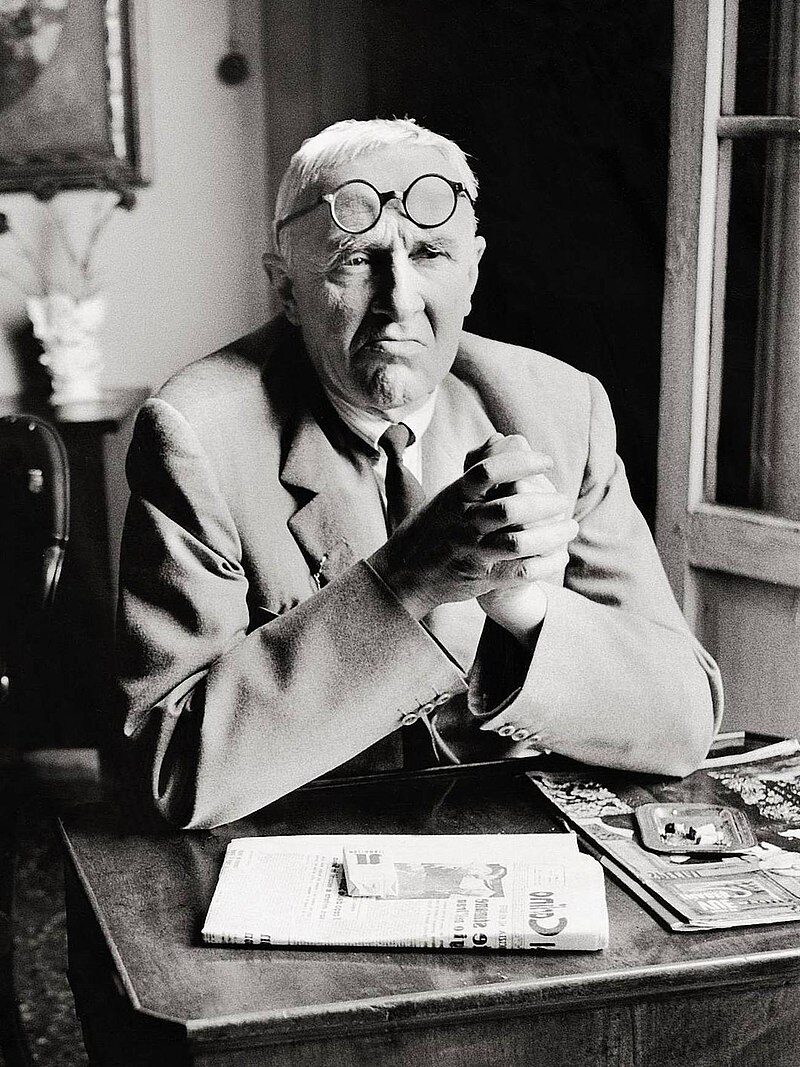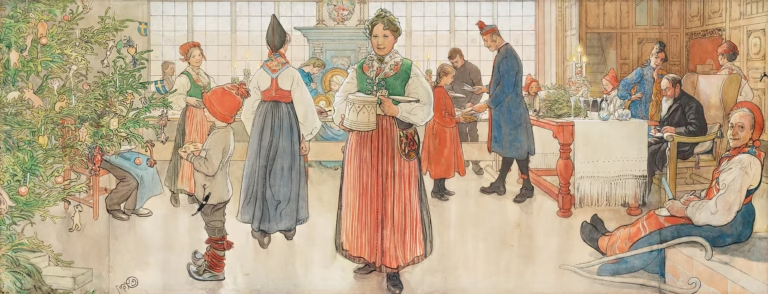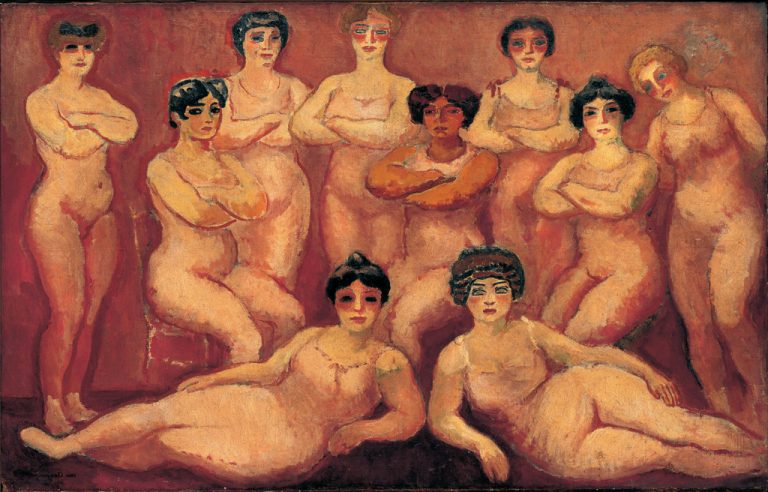Morandi Paintings: Exploring the Quiet Beauty of Still Life Art
Born: July 20, 1890; Castel Guelfo / Castel Guelfo Di Bologna, Italy
Death: June 18, 1964; Bologna, Italy
Art Movement: Metaphysical art, Magic Realism
Nationality: Italian
Influenced By: Piero della Francesca
Institution: Novecento Italiano
Morandi Paintings: Exploring the Quiet Beauty of Still Life Art
The Life of Giorgio Morandi
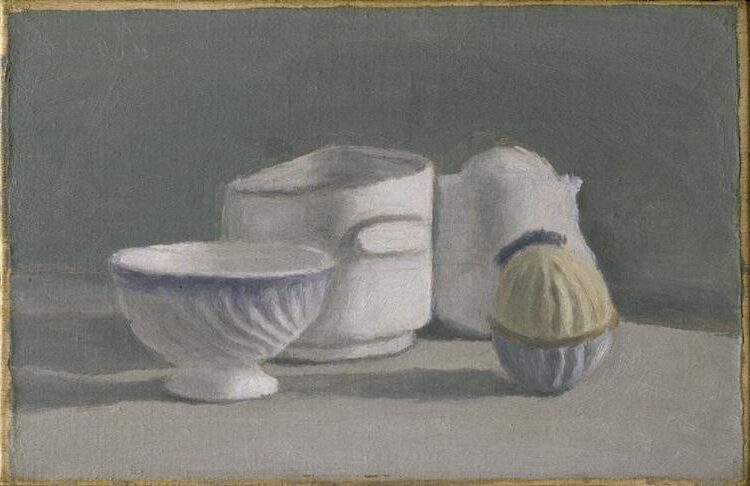
Still Life (1943) by Giorgio Morandi
Giorgio Morandi, an Italian painter and printmaker, spent his life in Bologna, Italy, where he developed his distinctive style. He attended the Accademia di Belle Arti and later became a respected professor of etching.
Early Years in Bologna
Giorgio Morandi was born on July 20, 1890, in Bologna, Italy. Growing up in a close-knit family, he showed an early interest in art. His childhood was marked by the vibrant cultural atmosphere of Bologna, which influenced his artistic sensibility. Despite facing personal hardships, including the loss of his father, Morandi pursued his passion for painting.
His hometown played a significant role in shaping his artistic direction. The city’s rich artistic heritage provided inspiration, and Morandi’s early works began to reflect the quiet, contemplative nature that would define his future creations.
By the time he entered formal education, he had already developed a keen interest in still life, a subject he would explore throughout his career.
Accademia di Belle Arti
Morandi attended the Accademia di Belle Arti in Bologna, where he studied from 1907 to 1913. This period was crucial in refining his skills and theoretical foundations in art.
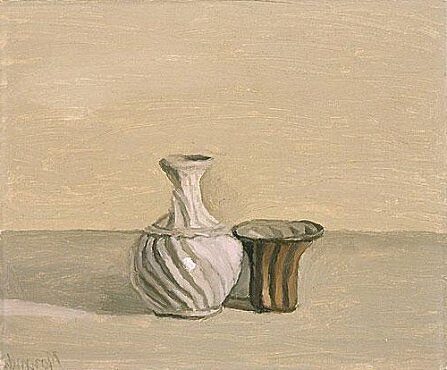
Natura Morta (1955) by Giorgio Morandi
At the academy, he was exposed to both traditional techniques and modern artistic movements, which broadened his perspective.
The curriculum was rigorous, and he studied under professors who were accomplished artists themselves. Through these experiences, Morandi honed his abilities in both painting and etching.
His exposure to various styles and techniques allowed him to create a unique art form that merged simplicity with depth. This academic background laid the groundwork for his future innovations in still life painting.
Career as a Professor of Etching
In 1930, Morandi began teaching etching at the Accademia di Belle Arti in Bologna. He served in this position for more than two decades, sharing his passion for art with students. His teaching was marked by a focus on technical precision and an appreciation for subtlety in art.
As a professor, he was dedicated to guiding students in discovering their own artistic paths. Morandi’s influence extended beyond his classroom; he inspired a new generation of artists with his minimalist approach. His own work and teaching both emphasized an understanding of form and texture, echoing the themes he explored throughout his career.
Artistic Style and Philosophy
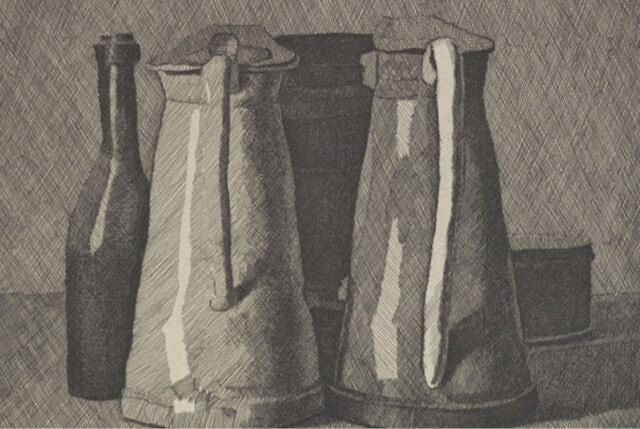
Still Life With Five Objects (1956) by Giorgio Morandi
Giorgio Morandi’s paintings are known for their subtle tones and serene compositions. His style and philosophy focus on tranquility and simplicity, often expressed through still life. He drew influences from both historical and contemporary art movements, contributing to his unique vision.
Influence of Cézanne and the Italian Renaissance
Morandi admired Paul Cézanne for his exploration of form and space, evident in Morandi’s own compositions. He absorbed Cézanne’s approach, integrating it with the Italian Renaissance’s emphasis on balance and harmony.
Piero della Francesca influenced Morandi’s method of structuring objects, contributing to the calmness and order present in his still-life paintings.
By merging Cézanne’s dynamic shapes with Renaissance techniques, Morandi achieved a distinctive style, focusing on the intimacy and depth of everyday objects.
Metaphysical Painting and the Strapaese Group
Morandi was associated with the Metaphysical Art movement, alongside figures like Giorgio de Chirico and Carlo Carrà. In this style, everyday objects were painted with a dreamlike quality, imbuing them with mystery.
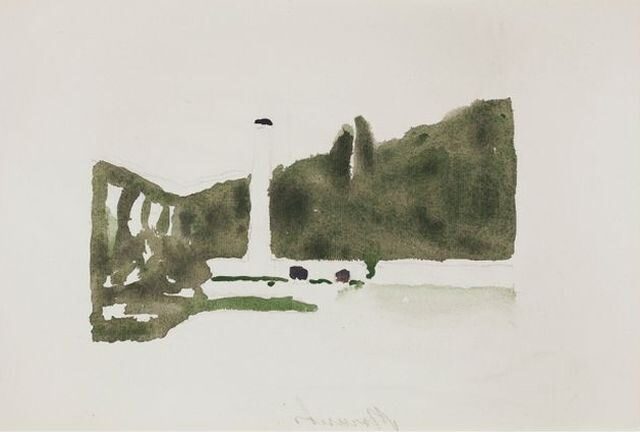
Landscape Levico (1957) by Giorgio Morandi
Although Morandi’s work maintained a quiet elegance, the influence of Metaphysical Painting can be seen in his focus on the stillness and presence of objects.
His connection to the Strapaese Group further emphasized traditional Italian values, aligning with his preference for maintaining privacy and tranquility through art.
Still Life and Natura Morta
Morandi’s still-life paintings, or “Natura Morta,” emphasize ordinary objects such as bottles, vases, and boxes. He placed these items in understated arrangements, highlighting their shapes and interactions.
His work is renowned for the tonal subtlety used to present seemingly simple subjects.
Through limited color palettes and muted tones, Morandi created a sense of serenity and composure, offering viewers a deeper appreciation of everyday beauty.
Focus on Composition and Light
Composition and light play vital roles in Morandi’s paintings. He used careful placement and balance to construct visual harmony.
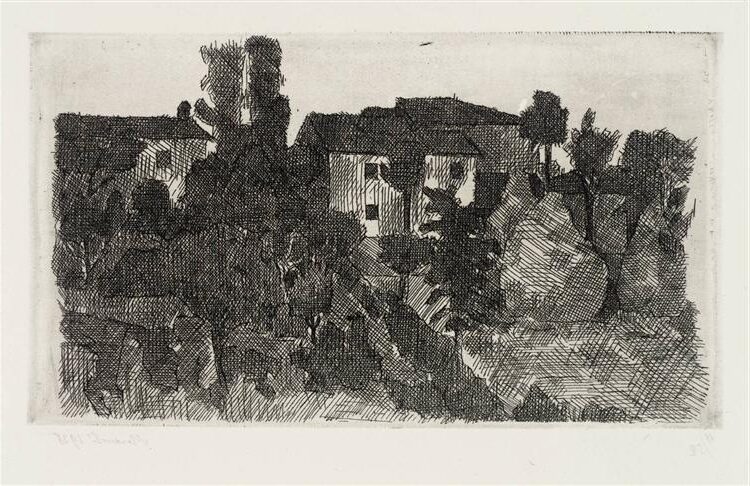
Hilltop at Evening (1928) by Giorgio Morandi
Objects are strategically positioned to create depth and spatial relationships that draw the viewer’s eye.
Morandi’s nuanced use of light enhances these compositions, casting gentle shadows and softening transitions between objects. This subtle play of light brings life to the still scenes, capturing the essence of time and space within his work.
Morandi’s Technique
Giorgio Morandi is renowned for his masterful still-life compositions, where he employed a unique blend of etching and painting techniques. His delicate approach to brushstrokes and color, coupled with his intricate craftsmanship of ordinary objects like vases and bottles, made his art highly distinctive.
Etching and Printmaking
Morandi was not only a painter but also an accomplished printmaker. He created exquisite etchings that matched the beauty of his paintings.

Monti di Grizzana (1929) by Giorgio Morandi
Morandi often used antique papers for their unique textures, providing a soft background to his subjects.
He experimented with techniques to achieve depth despite working primarily in black and white. His powerful use of cross-hatching contributed to a sense of colorism. This element brought a sophisticated and tranquil quality to his still-life works.
Exploration of Brushstroke and Color
In painting, Morandi’s brushstrokes were an important part of his style. He used them to give form and texture to everyday objects.
His brushwork was deliberate, allowing viewers to see the painting process while marveling at the simplicity of his subjects.
Morandi preferred a limited palette of subdued tones such as greys, browns, and chalky whites. These colors helped keep the focus on form and arrangement, allowing each object to stand out in its quiet glory.
The Craftsmanship of Vessels and Still Life Objects
Morandi had a unique way of arranging objects like vases, bottles, jugs, and bowls. These everyday items became subjects of deep artistic exploration.
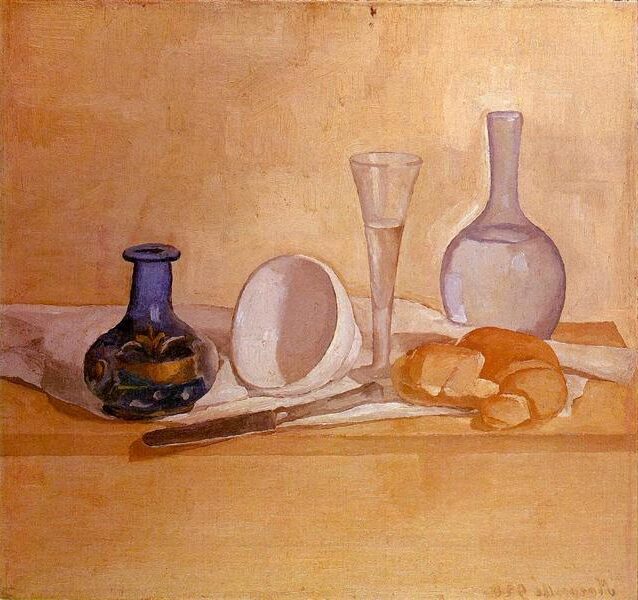
Still Life (The Blue Vase) (1920) by Giorgio Morandi
He presented them in simple compositions that emphasized shape and balance.
His attention to detail in the depiction of ceramic vessels and other still life objects was unparalleled. Through careful arrangement and subtle color use, he transformed these items into expressions of harmony and tranquility.
Exhibitions and Accolades
Giorgio Morandi‘s art has been showcased globally in renowned exhibitions, gaining significant accolades and strong market presence.
Venice Biennale and São Paulo Biennale
Morandi’s participation in prestigious events such as the Venice Biennale and the São Paulo Biennale helped cement his reputation.
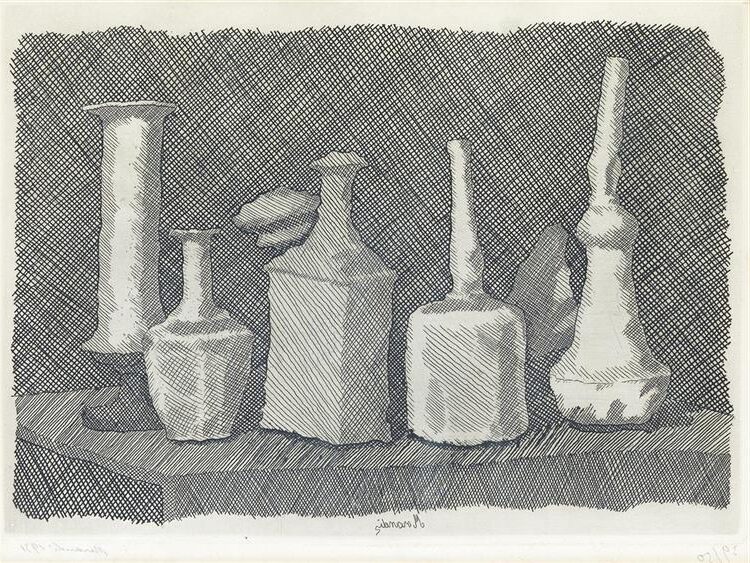
Natura Morta a Grandi Segni (1931) by Giorgio Morandi
In 1948, he was awarded the first prize for painting at the Venice Biennale, which marked a pivotal moment in his career. This accolade recognized his mastery in depicting everyday objects with a meditative quality.
Such honors elevated his status in the international art scene, aligning him with celebrated artists of his era.
The São Paulo Biennale further amplified his reach. His participation introduced his unique style to new audiences in South America, broadening his influence and establishing a global presence.
His success in these exhibitions underscored his innovative approach and steadfast dedication to his craft.
Museum Exhibitions Worldwide
Morandi’s art has been featured in some of the world’s most important museums. The Museum of Modern Art in New York and The Metropolitan Museum of Art have both held exhibitions highlighting his work.
These exhibitions often focus on his still-life paintings, which capture the intricacy and subtlety of everyday objects.
The National Gallery of Art and the Hermitage Museum have also showcased his work, reflecting his international appeal.
The Museo Morandi in Bologna is dedicated entirely to his art, celebrating his contribution to modern painting. His exhibitions offer visitors insight into his creative process and enduring legacy.
Auction Record and Market Presence
Morandi’s paintings continue to command impressive prices at auctions. His auction records highlight the sustained interest and high value placed on his work.
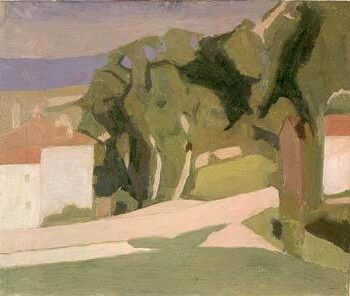
Paesaggio (1935) by Giorgio Morandi
Collectors and museums alike compete for his pieces, which are seen as significant investments.
The demand for his paintings reflects his status as one of Italy’s most celebrated 20th-century artists. His ability to convey depth and emotion through simple compositions ensures that his work remains highly sought after in the art market.
Morandi’s Influence and Legacy
Giorgio Morandi’s work has left an enduring mark on the art world. His unique style, characterized by subtle still-life paintings, not only stood apart in his time but also inspired future generations of artists. His influence spans across different art movements and continues to be celebrated in prestigious galleries globally.
Following World War II
After World War II, Morandi gained broader recognition. This period marked a turning point for him as his work received significant attention from international audiences.
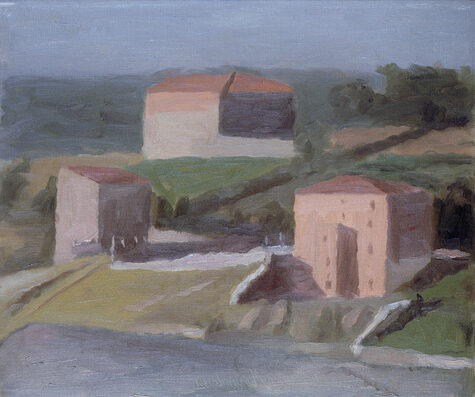
On the Outskirts of a Town (1941) by Giorgio Morandi
He was seen as a key figure in Italian art, particularly due to his focus on intimate, everyday objects. His still-life paintings, often featuring bottles and vases, conveyed a sense of tranquility and simplicity.
Morandi’s art reflected post-war sentiments, where many sought refuge in the familiar and the stable. He became a symbol of resilience through his art.
The minimalist nature of his paintings resonated with audiences, amplifying his reputation beyond Italy. The Museo Morandi in Bologna was later established to honor his contributions, ensuring his legacy remained influential and accessible.
Influence on Abstract and Minimalist Art
Morandi’s approach had a profound impact on abstract and minimalist art. His emphasis on form, space, and muted colors inspired many artists.
The way Morandi simplified objects to their essence foreshadowed trends that later emerged in abstract painting. His work influenced artists who sought to strip art down to its basic elements.
Minimalists appreciated Morandi’s restraint and clarity, which demonstrated how minimalism could communicate deep feelings and ideas.
He showed that simplicity did not equate to emptiness, but rather an exploration of balance and quiet introspection. Artists appreciating abstraction found inspiration in Morandi’s subtle color palette and compositional harmony.
Collections and Homages
Morandi’s paintings are housed in eminent collections worldwide, serving as a testament to his influential legacy.
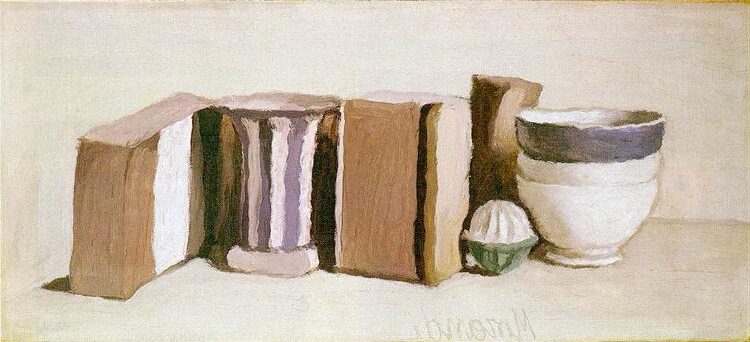
Still Life (Cups and Boxes) (1951) by Giorgio Morandi
Institutions like the Metropolitan Museum of Art preserve his work, showcasing his lasting importance in art history.
His pieces resonate with collectors for their timeless quality and introspective nature.
Notable collectors, such as Peggy and David Rockefeller, have been drawn to Morandi’s art, further cementing its value.
The Museo Morandi, dedicated to his oeuvre, hosts a large collection of his works and honors his contributions to art. These collections and exhibitions have inspired numerous homages, with contemporary artists recognizing Morandi’s unique vision and contribution to art.
Frequently Asked Questions
Giorgio Morandi was known for his delicate still-life paintings of everyday objects. His unique approach and subtle technique have left a lasting impact on the art world.
What techniques were commonly employed by Giorgio Morandi in his artworks?
Morandi often used oil paints and watercolors in his work. He was known for his careful attention to composition and muted color palettes, often featuring shades of grey, brown, and white. His brushwork was subtle and precise, focusing on creating a sense of tranquility and balance.
What is the significance of still life in Morandi’s body of work?
Still life was central to Morandi’s art, serving as a means to explore form and light. By using common objects like bottles and vases, he sought to convey deeper meaning and aesthetic beauty. His still-life paintings are celebrated for their simplicity and depth.
How has Giorgio Morandi influenced modern art?
Morandi has inspired many contemporary artists with his minimalist approach. Artists like Vija Celmins and Wayne Thiebaud have cited him as an influence due to his focus on everyday objects and attention to detail. His work continues to be studied for its subtle complexity and timeless appeal.
What are the distinguishing features of Giorgio Morandi’s still life paintings?
Morandi’s paintings are known for their muted color schemes and simple compositions. He commonly arranged bottles, vases, and jugs in understated yet harmonious ways. These elements, coupled with delicate shading, create a serene and contemplative atmosphere in his work.
Where can collectors find Giorgio Morandi paintings for sale?
Collectors looking for Morandi’s paintings can often find them through major art auction houses and galleries. Some pieces may also appear in international exhibitions or on the market through private sales.
How many paintings did Giorgio Morandi create throughout his career?
Throughout his career, Giorgio Morandi created approximately 1,350 paintings. His body of work continues to be highly regarded and is included in many prestigious art collections worldwide.

